Unless you’re a devout petrolhead, the car world can be one filled with confusing terminology.
From acronyms like VED (Vehicle Excise Duty, which is essentially car tax) to idioms such as referring to unreliable motors as ‘lemons’, there’s enough jargon to put your head into a spin.
And the recent generation of green cars is only adding to the already diverse automotive vocabulary.
While the term electric vehicle – or EV – is self explanatory, ‘hybrid’ isn’t quite as straight forward. In fact, there are four different types, some with very subtle differences.
What are the different types of hybrid car?
There are four different types of hybrid car on the market currently.
Here’s a brief overview of each, how they differ – and why one in particular SHOULDN’T technically be considered a hybrid…
1. HYBRID ELECTRIC VEHICLE (HEV)
Also known as: Hybrid, conventional hybrid, self-charging hybrid
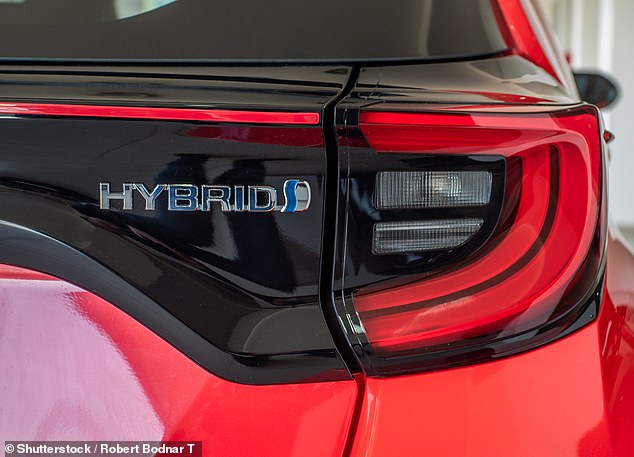
Conventional hybrids are those with a combustion engine (typically a petrol) with a supplementary small battery and electric motor
A hybrid electric vehicle has an onboard battery and electric motor to supplement a petrol or diesel engine.
However, it can’t be plugged in to be charged, so all of the electric power is generated by the movement of the vehicle.
Batteries are far smaller than those in fully electric cars and for this reason can only typically provide a handful of miles of range when exclusively running on electric power.
They’re often referred to as conventional hybrids as they were introduced to the market ahead of plug-in hybrids (which we will come to shortly), with the Toyota Prius being the most renowned model.
Because of their limited electric-only ranges and need to be charged by the car itself, these hybrids are seen as more outdated and are expected to give way to more plug-in hybrid cars.
However, despite this, sales are booming – as we outline below.
2. PLUG-IN HYBRID ELECTRIC VEHICLE (PHEV)
Also known as: Plug-in hybrid
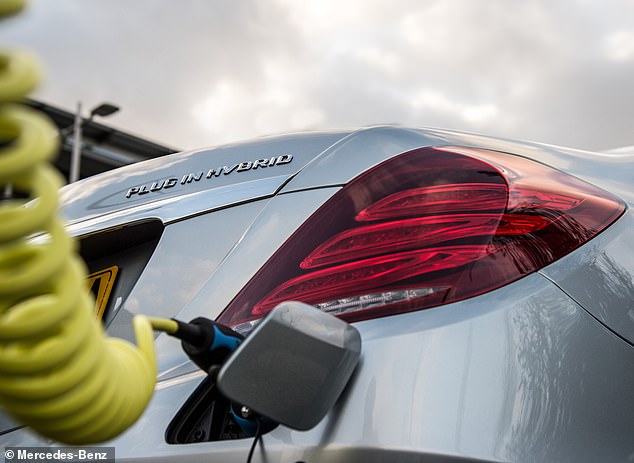
Plug-in hybrids commonly have a larger battery than a conventional hybrid and can be charged via the mains, a wallbox or public device
Plug-in hybrid electric vehicles also use an internal combustion engine – usually petrol but there have been some examples of diesel PHEVs – and an onboard battery and electric motor(s).
But the biggest difference to an HEV is that they also have a charging socket.
The battery can be charged by plugging into the mains, a domestic wallbox or public charging device.
Like HEVs, they also have energy regenerating brakes and systems that help to trickle a little extra capacity to the battery on the move.
The battery pack is not as large as those in fully electric cars but is bigger than units in HEVs.
This means that plug-in hybrids can be driven on electric power alone, with proponents arguing this makes them perfect for short-trip urban driving. When fully charged, a plug-in hybrid can provide anywhere between 25 and 60 miles of range using just electric power.
For longer journeys – or any trip where you’ve used up to electric driving capacity – the vehicle will become reliant on the petrol engine to take you to your destination.
Almost all manufacturers have introduced plug-in hybrid options, whether that’s a Ford Kuga, Audi A3, or a Bentley Bentayga.
3. MILD-HYBRID ELECTRIC VEHICLE (MHEV)
Also known as: Mild hybrid
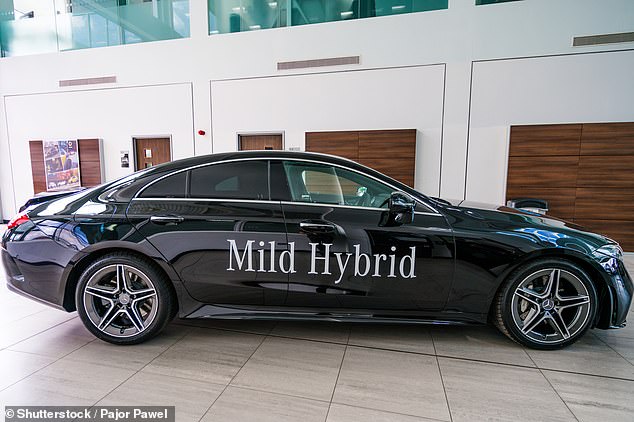
Mild hybrids are the latest form of ‘hybrid’ car to hit the market. However, at no time does the system power the wheels like an HEV or PHEV
One of the most confusing recent terms introduced to the sector is the mild hybrid electric vehicle (MHEV).
These are a middle-ground between a petrol/diesel car and a HEV and are becoming increasingly common in showrooms.
While they do have some electric capacity, to use the term ‘hybrid’ does muddy the waters.
These type of hybrid car has a very small battery and motor-generator – usually no bigger than 48 volts – to supplement the combustion engine under the bonnet.
However, the big difference to a HEV or PHEV is that the battery and motor does not provide all-electric propulsion at any time whatsoever.
Instead, the motor-generator uses stored electricity to supply additional torque to the engine, boosting its output without burning additional fuel to make the combustion engine more efficient.
Some mild hybrids also use the generator to enable the car’s engine to be turned off for up to 40 seconds when coasting, automatically restarting when acceleration is called for. This is said to offer greater fuel-economy from a petrol or diesel engine.
Examples, of cars that come as mild hybrids include the Ford Fiesta, the Jaguar F-Pace and Volvo XC60.
4. RANGE EXTENDER ELECTRIC VEHICLE (REX)
Also known as: Range extender, REEV
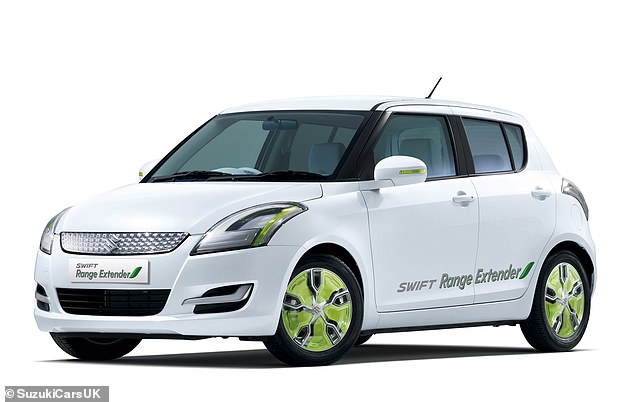
A range extender is the fourth and final type of hybrid car, which uses both a battery and combustion engine. However, it works differently to the three versions listed above
A range extender (REX) is the fourth different type of hybrid, though hasn’t been as popular as conventional or plug-in hybrid vehicles.
Arguably the best-known model is the Vauxhall Ampera, which was a short-lived early green car on sale between 2012 and 2015 – and one that’s still today considered ahead of its time.
While it does use a ‘hybrid’ of battery-plus-electric-motor and combustion engine, in a range extender the latter is much smaller than you’d find in the other types of hybrid car.
This is because the combustion engine acts as a generator – or auxiliary power unit (APU) – rather than a drivetrain.
This means the APU never sends power to the wheels. Instead, it only charges the battery or sends power to the e-motors.
For instance, when battery charge is low, the range extender starts automatically and charges it up.
While Range Extenders have been few and far between since the Ampera – and sister Chevrolet Volt (which was a much better name for an electrified car, in our opinion – was removed from showrooms in 2015, the technology is set to make a comeback thanks to pioneers British billionaire, Sir Jim Ratcliffe.
His new Ineos Fusilier – which is due on sale in 2027 – will be available either as a full-blown electric vehicle or an REX. Ratcliffe says the range extender is his personal preference as it provides ‘an improvement’ towards tackling global warming.
How popular are hybrid cars?
According to last year’s car registration figures published by the Society of Motor Manufacturers and Traders, one in eight (12.6 per cent) new cars sold in the UK last year were HEVs.
Some 238,942 were registered, making it the fourth most popular fuel type behind petrols (774,484), battery electric vehicles (314,687) and MHEV petrols (291,196).
The number sold last year was 27.1 per cent higher than the volume of HEV registrations in 2022 (187,948) and 62.3 per cent up on 2021 (147,246).
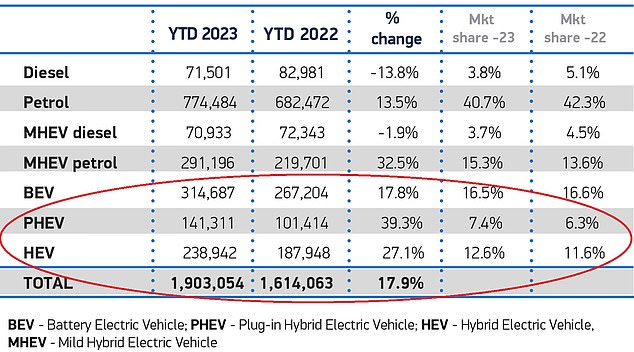
Conventional HEVs represented around one in eight new cars sold last year, while PHEVs account for approximately one in four passenger vehicle registrations in 2023
PHEV sales have been more turbulent.
In 2023, 141,311 plug-ins were bought in Briton, which represented around one in 14 (7.4 per cent) of all registrations last year.
This was a 39.3 per cent increase on the 101,414 registrations in 2022 (6.3 per cent market share), though the SMMT data shows more were sold in 2021.
Some 114,554 PHEVs were bought in 2021, which pushed market share to 7 per cent.
When will new hybrid cars be banned from sale?

The ban on sale of new petrol and diesel cars will also include hybrids from 2035
When, in November 2020, Boris Johnson originally announced that new petrol and diesel cars would be banned from sales from 2030, he said hybrid cars that were capable of ‘driving a significant distance without emitting carbon’ would be allowed to remain on sale beyond 2030 – but would eventually be axed from showrooms in 2035.
Since then, the Department for Transport refrained from disclosing what it deemed a ‘significant distance’, leaving the short-term future of hybrids in the air.
However, Rishi Sunak’s postponement of the petrol and diesel car sales ban to 2035 – which was confirmed just last year – and the arrival of the Zero Emission Vehicle (ZEV) Mandate has provided more clarity for hybrids.
The ZEV mandate was introduced into law in January and requires car makers to sell an increasing share of zero-emission – essentially electric – cars between now and 2035.
From 2035, it demands that all new models sold in the UK are zero emission, which outlaws hybrids – all of which production CO2 due to having a combustion engine.
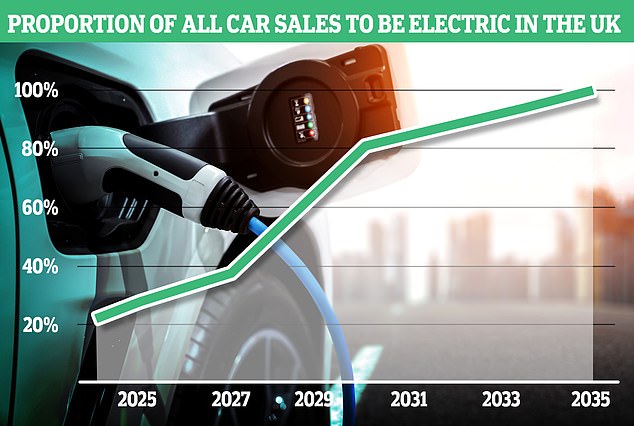
Electric future: The ZEV mandate will force car makers to sell an increasing volume of EVs between now and 2035 when the ban on sales of new petrols and diesels arrives
Should you consider a hybrid today – or have they run their course?
– IN FAVOUR OF HYBRIDS
Generally speaking, hybrid cars do offer fuel-saving benefits over conventional petrols and diesels.

Mike Hawes, chief exec of the SMMT, says hybrids are there for those not quite ready to make the switch to full EVs
They can also be driven (for varying lengths of time) in zero-emissions electric mode and – unlike fully electric cars – won’t ever give you range anxiety. They also benefit from lower vehicle excise duty (car tax) and are an attractive low-tax option for company car drivers.
It’s for this reason they are often considered a bridge between cars with internal combustion engines and full EVs.
Mike Hawes, SMMT chief executive, said: ‘Manufacturers have invested billions to offer a range of technologies and give every car buyer options to reduce their emissions.
‘Hybrid technologies have a crucial role to play on the road to zero emission transport, especially as they can act as a steppingstone for those who aren’t quite ready to make the switch into a fully electric car.’
– AGAINST HYBRIDS
As well as taking their official fuel economy claims with a pinch of salt, green transport groups have said that the claimed CO2 emissions quoted for hybrids can be far from how much they pollute when used on the road.
Green campaign group Transport & Environment – which refers to plug-in hybrids as ‘the car industry’s wolf in sheep’s clothing’ – recently released a report stating that its own tests found PHEVs emit up to three times their claimed CO2 emissions during real-world driving.
And its views of HEVs are equally critical.
Richard Hebditch, UK director at T&E, said: ‘The performance of hybrids in real world situations – whether self-charging or plug-in – shows they’re still emitting plenty of CO2.
‘The reality is that they’re a distraction from going fully electric and getting the carbon savings we actually need to meet the UK’s climate targets.’
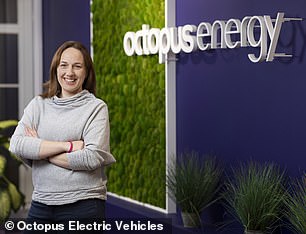
Fiona Howarth, CEO at Octopus Electric Vehicles, says hybrids are 2010s tech and an no longer needed to bridge the gap to EV ownership
Fiona Howarth, CEO of Octopus Electric Vehicles, also believes hybrid cars have run their course and should be overlooked entirely in favour of 100 per cent electric cars.
‘Hybrids have long been a stepping stone for drivers on their journey to using full electric vehicles,’ she told us.
‘Their familiarity allows drivers to feel like they’re taking a small step rather than a leap into the unknown. But a stone isn’t a steppingstone until you step off it.
‘I loved my Nokia and Blackberry, but with tech advances these have been replaced by the smartphone.
‘Hybrids were also great when batteries were more expensive, car makers are getting up to speed and the infrastructure wasn’t there – but they are tech of the 2010s.’
Some links in this article may be affiliate links. If you click on them we may earn a small commission. That helps us fund This Is Money, and keep it free to use. We do not write articles to promote products. We do not allow any commercial relationship to affect our editorial independence.



